Paul Miller’s digital workplace predictions for 2021

When the global pandemic took hold in the early months of 2020, an unintended but significant consequence was that we would suddenly embark on the largest shift in where work happens since the Industrial Revolution. In that instance, the transformation from agricultural/rural work to factory/urban work happened over decades, while in 2020 almost half of all workforces in developed economies left the physical workplace and started to work from home, pretty much overnight. This was described as “acceleration”, a word that doesn’t quite capture the intensity and speed of this work revolution.
And yet acceleration is in some ways accurate, in that the pandemic has forced changes in work that were already happening – but achieved at hyper-speed. Remote working, online meetings, flexible timetables, virtual teams, more collaboration. None of these aspects of work is new but the adoption (wanted or resisted) has been rapid, challenging and mostly successful.
It has felt as if the future arrived early. One of the big shocks and one mostly passed over without comment, despite its significance, is that when in the early months of 2020, the digital workplace became the essential and only workplace, the technology delivered. In the Decade of Courage Manifesto (released by DWG in May 2020), I posed the counter-scenario. Imagine that COVID-19 had necessitated the shutdown of all digital workplaces, while physical spaces could remain open. In that situation, work would have ground to a halt in minutes but, instead, most organizations have discovered that they could (after a few weeks of scrambling admittedly) function reasonably well. Thank goodness the virus arrived in 2020 and not in 2005 when the digital world lacked the resilience and power of today.
So, as I compile my seventh annual “Digital Workplace Predictions” from my current vantage point in October 2020, the experience is both familiar and yet strange. As in all years, this is a pause and time to reflect, but this year time feels fluid, as if the year has both barely started and yet also lasted an eternity. The chance to take stock now is a privilege and it is intriguing to review how I did with my 2020 predictions in this unusual year.
Here are my past ratings (all self-scored but then cross-checked with a selection of digital workplace practitioners).
Story so far:
2014: 7/10
2015: 7/10
2016: 8/10
2017: 7/10
2018: 8.5/10
2019: 7/10
So, how did I perform in 2020?
My performance in 2020 has been my poorest so far. In my defence, the strange developments of 2020 have delayed rather than deleted some of my predictions.
| Prediction 1 | ‘Accessibility’ rises in importance Cross – it didn’t. Other more pressing needs took centre stage but this concept of the ‘inclusive workplace’ has not gone away and will happen over time. | ✗ |
|---|---|---|
| Prediction 2 | Humans are winning 1/2 mark – there has been an emphasis on the humans in your workforce, with important capabilities in agility, empathy and the ability to make key decisions quickly. But there has been a ramp up in automation, AI and robotics because software cannot catch a virus. Of course, software can get infected by digital viruses, but it can also operate in environments that have been dangerous for human beings such as factories, logistics and transportation. | ✓ |
| Prediction 3 | Machine learning will be the focus area for organizations (rather than general AI), with some impressive examples emerging Tick – in fact this one should get two marks as Microsoft has boomed, driven by Teams and Office 365, with even hospital teams more comfortable having online meetings with colleagues to minimize physical contact. | ✓ |
| Prediction 4 | Digital literacy and work flexibility/mobility join forces Tick – we drew on the level of digital skills and worked far more flexibly. Organizations also rolled out digital literacy programs (or realized they needed to) as we are only as strong as our weakest digital link. | ✓ |
| Prediction 5 | The youngest workers raise the digital bar ever higher 1/2 mark – there have been stories of younger workers used ‘digital gyms’ and ‘online cafes’ to stay as social as possible. But it has been patchy and there has not so far been a strategic pattern where companies upgrade their digital world of work to keep pace with a younger workforce. | ✓ |
| Prediction 6 | Environmental ambitions start to affect how and where work happens. Tick – one of the big wins from the collapse of work travel and commuting has been environmental. And while the driver was not ecology per se, that has been the consequence and organizations now want to lock these climate change gains into their ways of working. | ✓ |
| Prediction 7 | Hiring dedicated enterprise search experts gains ground Cross – they didn’t. this was pushed down the agenda due to what were perceived to be more urgent priorities but it’s day in the sun is coming. | ✗ |
| Prediction 8 | Analytics, measurement and insights reveal hidden patterns in how work happens Tick – and a significant feature of this year. There are ethical questions but data and analytics has surfaced useful information about where, who and how work is happening. | ✓ |
| Prediction 9 | Increased budgets are allocated to behaviour and culture change Cross – many are thinking about this for 2021 but it has not taken off in 2020. Instead changes in behaviour change have been forced on large swathes of the workforce with little direct cultural change management. | ✗ |
| Prediction 10 | Importance and resourcing of ‘Digital HR’ accelerate Tick – right team at the right time. Digital HR has been gaining ground for a few years but those companies who had resource in this area were able to expand and others became aware that this was a now critical need. | ✓ |
My Super Prediction 2020
Organizations continue to restructure themselves – spurred on (in part) through digital workplace innovation
My Super Predictions don’t get marks per se – so that each year’s scoring can compare with earlier years on a like-for-life basis – but here are my comments on how I did Super Prediction-wise this year: A cautious confirmation that it mostly rang true because restructuring has been happening. However, this has been at business unit and regional levels, and less so at the organization-wide level – so far.
For example, in 2020, offline retailers created new online divisions and teams in weeks; banks deployed sales teams as “customer listening” groups; and large pharmaceutical units collaborated with public sector bodies and competitive companies, in ways unheard of in the past. But the drivers for these new structures were not derived from a desire to innovate in the digital workplace but instead from the primal need to keep trading and functioning as an organization.
Wider restructuring will increase in the next year, particularly as companies absorb the scale of the ripple effects of 2020 and realize that key parts of how they are set up no longer make sense.
6/10 – 2020
This might be my lowest score yet but in such a strange year, I can live with a modest level of success (and failure).
My 10 digital workplace predictions for 2021
Prediction 1: Cost cutting: the days of financial austerity (for intranets and the wider digital workplace) return for hard-hit economic sectors.
After the 2008 financial crash and ensuing global recession, there was a bout of collective belt-tightening across all sectors and regions – and digital workplace services (mostly located in intranets at that time) had to make do with far less budget.
Digital workplace teams and leaders are well-practised in working creatively to make sure they provide the optimum services for the least cost. This will stand them in good stead as the financial constraints in badly affected industries hit home. Airlines, travel, hospitality and physical retail are already experiencing severe hardship and teams there will need to work with the existing technologies and licences smartly to keep providing good services for colleagues.
Interestingly, some of the most innovative intranets after 2008 (an area where there will be strong focus yet again, now 15 years after intranets were pronounced “dead” by some) were those navigating the toughest cost restraints. We can expect some innovative intranet practice and improvements in 2021 from organizations in the most depleted sectors.
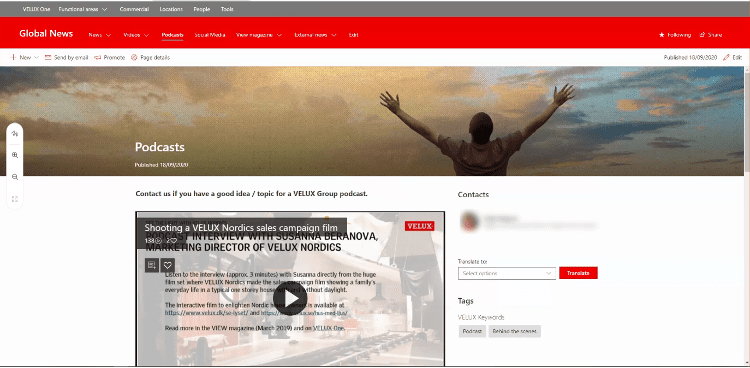
VELUX’s new digital workplace and intranet is built mainly on SharePoint Online out-of-the-box, hugely reducing costs on the previously customized intranet, with no loss of capability
Bigger picture
This austerity period will pass but retaining capacity in your digital workplace team to know how to manage in tough times will remain of great value. The future is a strange and surprising space and we are all only as strong as our preparations.
Prediction 2: Learning and Development ramps up to improve digital literacy, innovation and new ways of working for a changed (and still unfamiliar) working environment and economy.
Some of the differences in capability in 2020 have been stark. One European energy producer was able to ensure 95% of its workforce could work from home, operating power stations remotely and securely, keeping only a skeleton staff on site; in contrast, one US homeware retailer struggled to scale up its online offerings for several months in the first half of 2020.
Some of this and similar variations may have been due to systems and services, but often the key “magic ingredient” and differentiator in successful distributed working is the level of digital literacy and readiness within the workforce. Responding to COVID-19 was as much a question of skills and capability as it was about digital workplace services.
In 2021, Learning and Development will increase steadily to drive forward innovation and raise digital skills and understanding at all levels of the enterprise, strengthening the resilience and adaptability of organizations.
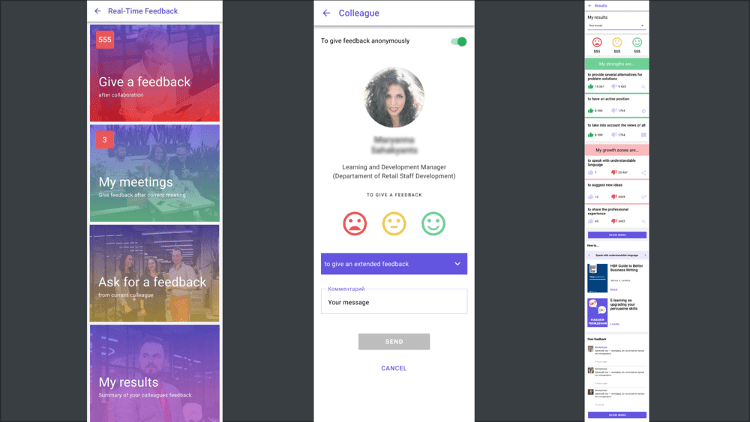
Russian retailer M.Video Elodrado Group supports learning for frontline employees by suggesting valuable learning resources based on feedback received from peers
Bigger picture
Continual, incremental learning, driven by AI, will flow through all organizations and their wider ecologies of work with suppliers and partners, etc. While the digital IQ of people will have increased significantly, continuing as a living, learning community will be essential for the health of the overall system.
Prediction 3: Leaders extend empathy, using digital spaces to listen to and engage, with a widely distributed workforce, strengthening their cultures.
In conversations with leaders across sectors and regions, one common thread they shared in 2020 was how much they had enjoyed new experiences getting to know colleagues more personally during the COVID-19 pandemic. One financial services company was typical in admitting that it initially tried to run a more controlling management approach in January 2020 when the virus was turning work and life upside down in the Far East. However, they quickly realized that their staff were struggling, scared and trying to work in difficult physical conditions, and with high levels of emotional stress. Leaders and managers stopped talking and started listening – and it worked. Empathy became one of the words of 2020.
This new level of patience and understanding allowed leadership at all levels to feel more human themselves as they shared their own challenges. Not only did this strengthen corporate cultures but made work easier for everyone. This is an experience that was valued deeply by leaders (along with accelerated decision-making) and is one that will be normalized and grow in 2021. Empathetic leadership is here to stay.
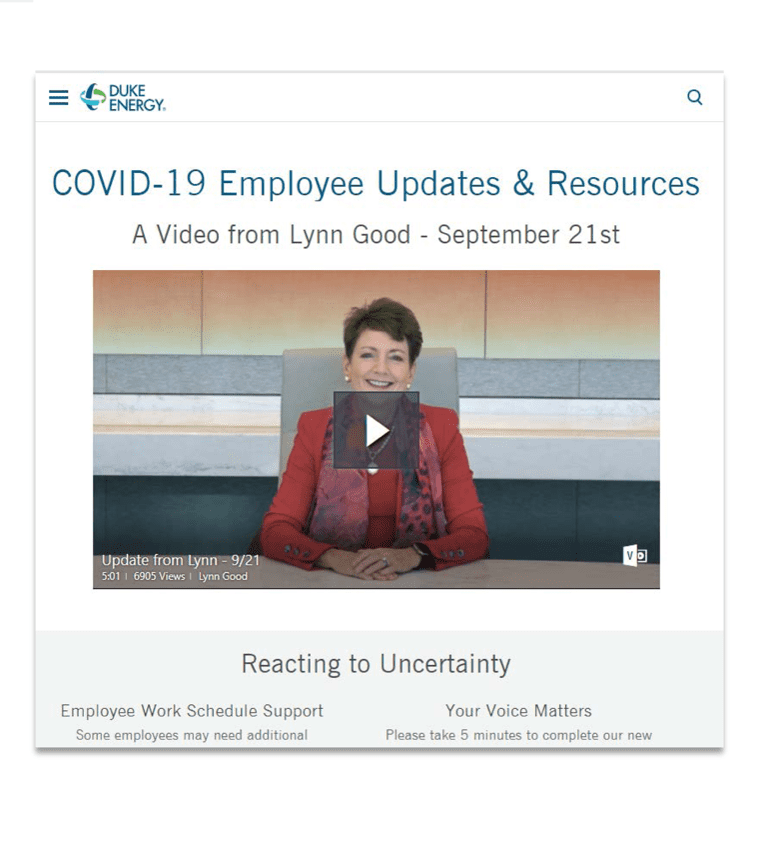
Duke Energy’s CEO has communicated regularly with employees during the pandemic
Bigger picture
The experience of rapid decision-making, married with a lack of politics and bureaucracy in 2020 leaves a lasting legacy, and organizations of all sizes will strip away layers to connect liberated leaders with an empowered frontline to create more adaptive, natural and fluid structures and processes.
Prediction 4: Knowledge Management takes center stage yet again – as part of the on-going adaptation to working in distributed and hybrid ways of working, accelerated by the global pandemic.
The likes of EY, Ubisoft and Volvo have shown that a relentless focus on ensuring knowledge flows through systems and people is essential. Now, more companies will seek to deliver robust access to a wider pool of expertise, collaboration and insight from humans, as well as from intelligent systems, to help ensure innovation and rapid response capability.
As the workforce and workplace become ever more distributed, so the role of knowledge management increases in importance. We have seen in 2020 through knowledge sharing across healthcare competitors, sectors and regions during the pandemic, that the key to innovation and speed is mobilizing the power of what you know.
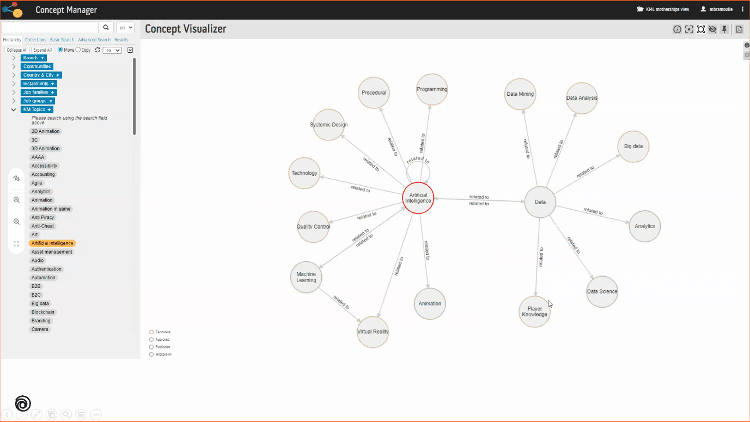
Ubisoft’s advanced digital workplace is underpinned by robust knowledge management approaches, including managing an advanced enterprise taxonomy.
Bigger picture
Finally, the capacity of AI and intelligent systems to work in harmony with human beings enables new levels of knowledge to share and grow at dramatically richer levels. Extracting true insights and equipping everyone with access to the vast amounts of knowledge that exist across an organization and its wider ecosystem will be become part of natural ways of working.
Prediction 5: Enterprise technology providers innovate to free organizations from some of the constraints caused by the relentless rise of Microsoft.
Most large organizations in most of the world have a substantial Microsoft presence in their digital workplace. However, while levels of customer satisfaction with Microsoft have risen under the leadership of the current CEO Satya Nadella, there are concerns about the limitations of this “one size fits all” macro workplace. How do we create a unique look, feel and range of services that suit our brand and culture if we have to follow a Microsoft playlist?
The more open approach introduced under Nadella has enabled a wider range of supporting and innovative services to be created that can work alongside Microsoft. For example, US software firm Workgrid has developed a powerful intelligent assistant that works well with the Office 365 suite of services. Creative services, existing and new, which can exploit the Microsoft platform, will provide more of the distinctive experiences large organizations want and need.
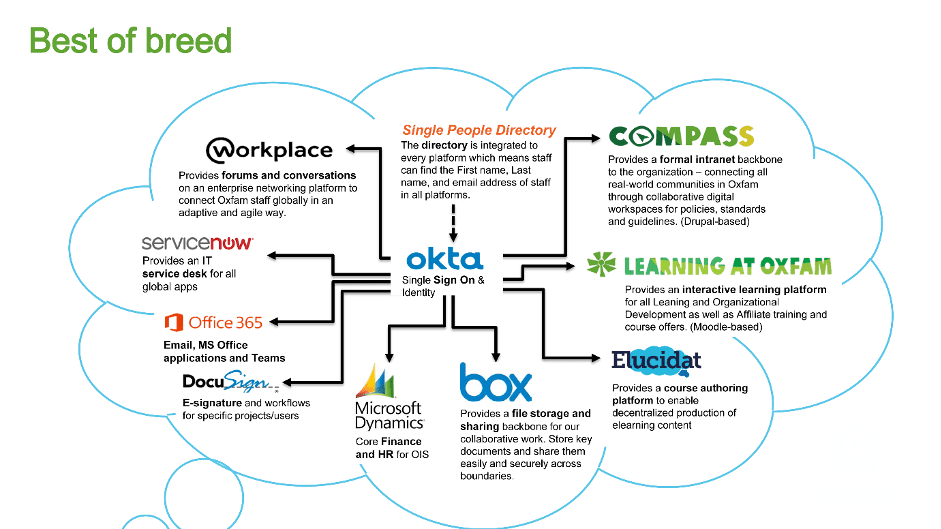
Oxfam International’s strong digital workplace is based on a best-of-breed approach, utilising a range of Microsoft and non-Microsoft applications
Bigger picture
The digital space will merge far more, combining elements that we might consider to be either “inside” or “outside” and, while Microsoft is likely to remain significant in work, there will also be available a wide array of smaller services and experience providers to ensure dynamic and personalized ways of working for different companies. This will include platform options other than Microsoft, brought in from the “external” world, such as Adobe and Amazon.
Prediction 6: Virtual, augmented and mixed reality online meetings enable new experiences of emotional connection
As we all know, one of the downsides of remote working in 2020 has been the monotony (through a two-dimensional flat screen) of endless virtual meetings with colleagues. People naturally miss the special quality that comes from physically meeting and, while the digital replacements – whether via Microsoft Teams, Zoom or WEBEX (and other providers exist, of course) – function well enough, this way of meeting still lacks the richness and texture of being together in person.
2021 will deliver an energy boost, with new worlds of virtual, augmented and mixed reality connections appearing. These three-dimensional, immersive spaces are already being used with great success externally. For example, L’Oréal’s “MakeUp Genius” app allows customers to try on makeup remotely and IKEA’s mobile app provides more than 2,000 IKEA products online, with users able to point their device to a desired spot in a room, then drag and drop the selected product into the space.
Augmented reality, blending text, graphics and audio with real-world objects, will become a boon for the workplace of the future, allowing co-workers to collaborate remotely using digital avatars and 3D virtual objects that can be viewed and manipulated in real-time during a meeting. This and other 3D realities, such as holograms, will allow us to narrow the gap with being together in person.

A screenshot from Spatial, a leading app supporting collaboration and meetings using Virtual Reality (VR) and Augmented Reality (AR)
Bigger picture
The two-dimensional Zoom or Teams call of today will seem archaic in coming years as the holographic presence of colleagues becomes routine. Once we pass the point where our perception and senses convince us that we are all in the same room, we will find our virtual meetings and connections will be transformed.
Prediction 7: Frontline and customer-facing workers finally enjoy the digital acceleration they always deserved
Irrespective of region or sector, the frontline (or firstline) workers have been the standout heroes of 2020 – particularly those in essential services and others included in the “key worker” category. When the world pressed “pause” in the first half of 2020, those on the front line kept on delivering, making the best use they could of the digital workplace services they had available to them.
Now that this unique turn of events has become normalized, attention will turn at an accelerated pace to ensuring that those on the front line are saturated with the best digital services possible, rather than (as has been the case) being the poor relation when it comes to investment.
Microsoft Teams was extremely popular even within hospitals, as healthcare staff could meet safely rather than having to spend time physically together when it wasn’t essential. We will see increased analysis of the daily experience of frontline workers to ensure they enjoy the digital services that make their work easier, faster and more adaptive.
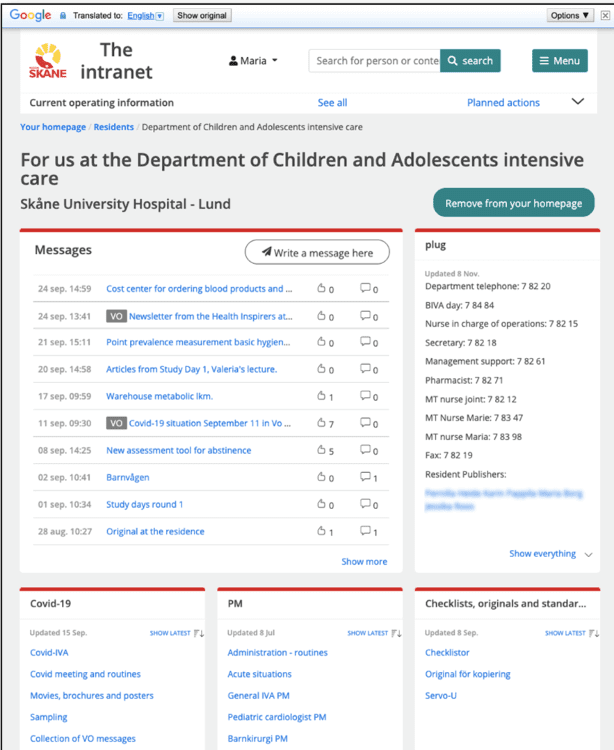
Frontline clinical staff in the hospitals within Region Skane in Sweden have a focused workspace available on the intranet to support their work
Bigger picture
Power and investment will focus on the points where organizations actually deliver their services and products. New, highly portable and resilient tools and services will be available where they are most needed – with the frontline workers – and these services will be fully integrated with the customer experience.
Prediction 8: Workplace analytics and behavioural insights are harnessed to help manage digital fatigue, well-being and workplace health
In our Decade of Courage Manifesto 2020, DWG said that COVID-19 transformed the digital workplace into the essential workplace. When we needed the technology to deliver, it mostly did a solid job.
But we also saw that, while remote working improved productivity (counter to previously assumed beliefs), the impact on employees was significant. Digital fatigue, Teams and Zoom monotony, isolation and struggles with mental and physical wellbeing all came to the surface.
2021 will be the year in which organizations use their data and analytics – plus improved management approaches – to ensure their people are better supported. Knowledge of cognitive patterns, behaviours and anthropology will be combined with analytics to provide each person and team with a work week designed to suit them. How people feel and how healthy they are will be core workplace factors that will be better managed and governed.

The team at Fidelity International are tracking collaboration analytics
Bigger picture
The desire to treat everyone in the organization as a human being with unique skills, patterns and needs in work and life will lead to a much healthier workplace, where intelligent systems not only reveal what is actually happening (and even how we are feeling) but also help to optimize our working environment to suit each person and team. Work will feel far more natural to everyone.
Prediction 9: Physical workplaces make a welcome return but local workplace ‘pods’ gain popularity as alternatives to working from home – while the digital workplace takes centre stage as the essential workplace
This trend was already in flight pre COVID-19. But in 2021, as physical workplaces become occupied again (and they will, because humans crave social and physical connection regularly in work), we can take stock of where work is happening in 2021. What will remain, as this physical reconnecting emerges, is the knowledge that the centre of gravity for work has now moved fully into the digital realm.
Imagine the counter-scenario, where COVID-19 had caused digital rather than physical workplaces to close. Within minutes most work would have stopped. But when the offices were forced to shut in early 2020, most work continued to happen quite well.
As we return to physical workplaces, the social, collaboration and cultural roles played by new-style workplaces will be valued hugely – and we will innovate. The hybrid workplace will produce pods close to where we live, where we can work alongside colleagues and fellow co-workers.
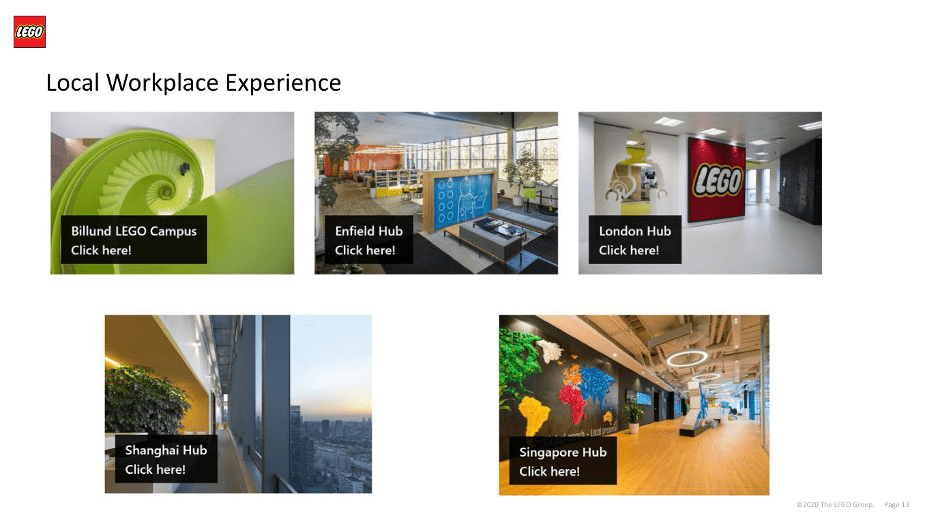
LEGO Group takes a joined-up approach to the digital and physical workplace, ensuring they deliver an overall workplace experience aligned to LEGO’s distinctive values, culture and brand
Bigger picture
Local work pods close to where people live will become normal. The central office will become part of the “history of work”. Where we meet and connect will be in new-style working spaces, meeting new social, cultural and innovation needs. The digital spaces themselves will also become more attractive to work in and draw on designs from the online gaming and entertainment worlds.
Prediction 10: Large organizations open new ‘Digital Headquarters’ where all are welcome.
In 2017, US insurer Northwestern Mutual was planning the gala opening of its new physical HQ called “The Commons” and was understandably proud of its new centre. The digital workplace team connected alongside with a new idea that also gained traction. Why not open a “digital HQ” at the same time to show that not only was the physical world of work moving forward but so was the digital? This concept captured attention and imagination.
Fast forward and, while the Northwestern Mutual Commons and Tower in Milwaukee is having to be rescoped for a COVID-19 world, its “digital sister” now looks like an idea ahead of its time. When most companies of all sizes find their physical locations constrained, or even empty, an inspiring and fully inclusive new approach is to launch a digital HQ. Unlike a typical physical HQ, which only a select few can use, the digital HQ can share space with all colleagues, anywhere in the world and at all levels.
Some digital HQs will be creative and bring in variations of real-world architecture to create digital spaces worth working in. The digital HQ is an idea whose time has come.

In Barclays Now, the bank’s global digital workplace, the distinctive branding feels like a natural extension of the physical workplace
Bigger picture
Roll forward a few years in a post-pandemic world; a world of work that never returned to the so-called 2019 “normal” but is instead one altered in structural ways. The original concept of the digital HQ will expand to become a common feature of larger companies. Interestingly, these HQs will gain the variety of style and character seen in physical HQs, with digital HQs becoming centres of inspiring, playful and engaging spaces designed by the “digital architects” that will emerge soon, probably recruited from the online gaming sector.

CISCO’s high-performing intranet and digital workplace is enabled by strong governance processes and structures, including a Digital Employee Experience Steering Group
2021 Super Prediction
Most organizations in most countries begin to transform the way they work. The shift in ‘where we work’ will open new doorways of opportunity (that many companies will enthusiastically grasp) to become ‘living organizations’ – as part of a new story of work for a living age
Companies will start to function less as machines and more as living entities, changing their view of themselves from organization to organism; from factory to forest. 2020 will be regarded as a watershed when, after we communally pressed “pause”, we decided to reimagine work for a new living age as part of the Decade of Courage.
This is part prediction and part hope. And this deep-level shift from factory to forest (as a metaphor) will flow through all organizations and communities at variable rates. It is the premise at the roots of our new book, Nature of Work: The new story of work for a living age, written by myself and my co-author, Shimrit Janes.
In 2020, the future arrived early. Patterns that had been shaping work for decades arrived in weeks and months. 2021 is the year when large organizations will decide to seize the moment and design new ways of working, with a new language for the inspiring futures they desire.
In summary, Paul’s 10 predictions for 2021 are:
- Cost cutting: the days of financial austerity (for intranets and the wider digital workplace) return for hard-hit economic sectors.
- Learning and Development ramps up to improve digital literacy, innovation and new ways of working for a changed (and still unfamiliar) working environment and economy.
- Leaders extend empathy, using digital spaces to listen to and engage, with a widely distributed workforce, strengthening their cultures.
- Knowledge Management takes center stage yet again – as part of the on-going adaptation to working in distributed and hybrid ways of working, accelerated by the global pandemic.
- Enterprise technology providers innovate to free organizations from some of the constraints caused by the relentless rise of Microsoft.
- Virtual, augmented and mixed reality online meetings enable new experiences of emotional connection
- Frontline and customer-facing workers finally enjoy the digital acceleration they always deserved
- Workplace analytics and behavioural insights are harnessed to help manage digital fatigue, well-being and workplace health
- Physical workplaces make a welcome return but local workplace ‘pods’ gain popularity as alternatives to working from home – while the digital workplace takes centre stage as the essential workplace
- Large organizations open new ‘Digital Headquarters’ where all are welcome.
Take the next step…
Categorised in: Uncategorized

